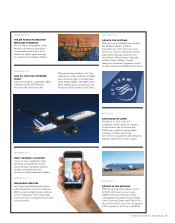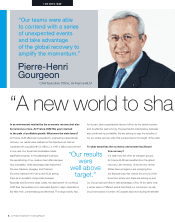Air France 2011 Annual Report Download - page 19
Download and view the complete annual report
Please find page 19 of the 2011 Air France annual report below. You can navigate through the pages in the report by either clicking on the pages listed below, or by using the keyword search tool below to find specific information within the annual report.
How did the Cargo division perform during the 2010-11
financial year?
After a 2009-10 during which global air freight activity had been very
badly affected by the crisis, we returned to profit with a positive
operating result of €69 million. We comfortably exceeded our objective
for this year which was to halve our losses, effectively demonstrating
that the cargo business is seeing a strong recovery.
What was behind this recovery and return to profitability?
Firstly, we were able to make the most of the pick-up
in demand in 2010, which enabled us to gradually
regain a higher level of unit revenues. We were
then able to take advantage of the adjustment
in capacity with, notably, the reduction in full freighter
flights, something we had initiated when the crisis
struck. We were also able to redistribute capacity
and restructure the cargo network at the level
of the Group: by reducing surplus capacity out
of our two hubs, focusing on belly and combi capacity and allocating
additional cargo capacity to our busiest routes.
Have these changes led you to review
your commercial policy?
Yes, Air France-KLM Cargo launched an in-depth redefinition
of its commercial policy to adapt it to the new business model.
This redefinition was based on a revised customer segmentation and
a simplified product portfolio. We are increasingly developing e-services
(e-booking and e-freight) to improve the quality of service, offer real-time
track and trace on shipments and reduce distribution costs.
Do the changes in your product also involve network changes?
In terms of the network, the cargo business is benefiting from
the opening of multiple new routes in the passenger business. But
the development of cargo also benefits from the integration of the
Dutch company Martinair, which makes a significant contribution to
the realization of this new strategy by reinforcing the
Group’s position in the market. Our aim is to leverage
the expertise of Martinair, particularly in terms of its
flexibility and adaptability to market needs.
Air France-KLM has thus reoriented its offer
by prioritizing the bellies of passenger aircraft
and combis. How has this new strategy been
tailored to customer needs?
Most cargo customers don’t need specialized forms of transportation.
They are looking for a timely service at the best price. This is generally
what is offered by the bellies of passenger aircraft. That being said,
it is easier to program full freighters than passenger aircraft on different
routes or with additional stopovers to respond to specific needs.
Full freighter capacity can also be required for high-volume shipments.
Our belly-dominant mixed model offers our customers solutions that
respond to their specific needs, at attractive tariffs.
“The return to profitability
proves that the cargo business
is seeing a strong recovery.’’
Camiel
Eurlings
Executive Vice President,
Air France-KLM Cargo
C U S T O M E R S
“We are
increasingly
focusing on
the quality
of service.”
Air France-KLM 2010-11 Annual Report _ 17
























